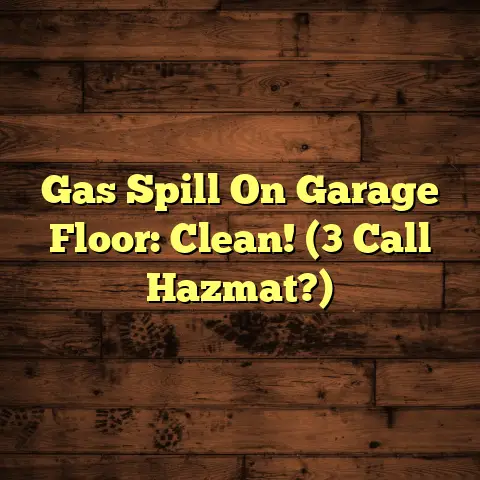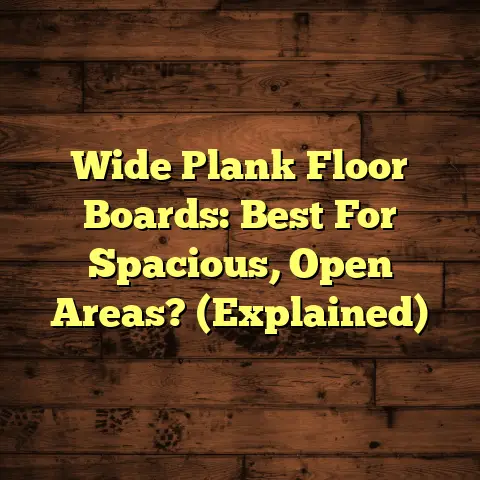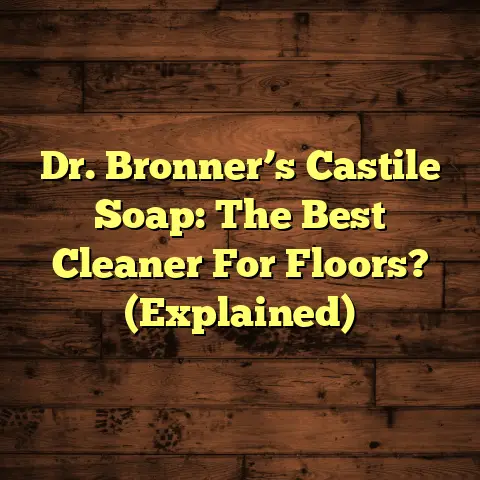Buff Hardwood Floors Yourself? (3 Mistakes!)
And let me tell you, there’s nothing quite like the warmth and elegance of a well-maintained hardwood floor. It’s a statement piece, a foundation for your home’s style, and a joy to walk on.
But keeping those floors looking pristine can feel like a never-ending battle, right? That’s where DIY maintenance comes in, and specifically, buffing your hardwood floors.
Think of it as a spa day for your floors! A chance to refresh the shine, remove those annoying superficial scratches, and give your home a little facelift without breaking the bank.
Quick Win: Save Money, See Results!
Here’s the deal: hiring a professional to buff your hardwood floors can easily set you back a few hundred dollars, depending on the size of the area. But with the right knowledge and a little elbow grease, you can achieve impressive results yourself and save a bundle!
Buffing is a fantastic way to maintain the protective finish, extend the life of your floors, and avoid the more drastic (and expensive) step of sanding and refinishing.
But before you grab that buffer and dive in, let’s talk about the potential pitfalls. I’ve seen too many homeowners make mistakes that end up costing them more time, money, and frustration in the long run.
So, let’s get into the nitty-gritty. I’m going to share my insider knowledge on the three biggest mistakes to avoid when buffing your hardwood floors yourself. Trust me, knowing these will save you a headache (and potentially a whole new floor!).
Section 1: Understanding the Importance
of Buffing Hardwood Floors
Okay, let’s get down to brass tacks. What exactly is buffing, and why should you even bother?
Buffing is essentially a gentle polishing process that removes surface-level imperfections and restores the shine to your hardwood floors.
Think of it like this: sanding is like a major surgery, removing a layer of the wood itself to address deep scratches and damage. Refinishing is like applying a fresh coat of paint, completely changing the look and feel of the floor.
Buffing, on the other hand, is like a facial. It’s a less invasive treatment that focuses on the surface finish, removing dirt, grime, and minor scratches to reveal the beauty underneath.
So, what’s the point? Why not just skip buffing and wait until you need to sand and refinish?
Well, buffing plays a crucial role in maintaining the protective finish of your hardwood floors. This finish acts as a shield against everyday wear and tear, protecting the wood from moisture, stains, and scratches.
Over time, this finish can become dull and scratched, making your floors look tired and worn. Buffing removes these imperfections and rejuvenates the finish, extending its lifespan and preventing the need for more drastic measures.
Think of it as preventative maintenance for your floors. Regular buffing can significantly prolong the life of your hardwood and save you thousands of dollars in refinishing costs down the road.
Now, let’s talk about those finishes. Different types of hardwood finishes require different buffing techniques and products.
Here’s a quick rundown:
-
Polyurethane: This is the most common type of finish, known for its durability and water resistance. Polyurethane finishes can be buffed with a variety of products, but it’s important to use a buffer pad specifically designed for polyurethane.
-
Oil-Based Finishes: These finishes penetrate the wood, providing a natural look and feel. Oil-based finishes require special buffing oils and techniques to avoid damaging the wood.
-
Wax Finishes: These finishes are less common but offer a beautiful, traditional look. Wax finishes require regular buffing with wax-specific products to maintain their shine and protect the wood.
-
Aluminum Oxide: This finish is incredibly durable and scratch-resistant. Buffing an aluminum oxide finish is generally not recommended, as it can damage the finish and void the warranty.
Important Note: Always identify the type of finish on your hardwood floors before attempting to buff them. If you’re unsure, consult with a flooring professional. Trust me, it’s better to be safe than sorry!
Section 2: Common Mistakes to Avoid
When Buffing Hardwood Floors
Alright, let’s dive into the meat of the matter: the three biggest mistakes I see homeowners make when buffing their hardwood floors. Avoiding these pitfalls will save you time, money, and a whole lot of frustration.
Mistake #1: Using the Wrong Equipment
This is a big one, folks. Using the wrong equipment can not only damage your floors but also make the entire buffing process a complete nightmare.
Let’s break down the essential equipment you’ll need:
-
Floor Buffer: This is the heart of the operation. Floor buffers come in various sizes and types, from small, handheld models to large, professional-grade machines.
For most homeowners, a standard 12-13 inch floor buffer is sufficient. These buffers are relatively affordable and easy to maneuver.
I’ve seen folks try to use a polisher instead of a buffer. It is a big mistake, and I don’t recommend it. Using a polisher can damage the floor.
Avoid using a buffer that is too heavy or powerful, as it can be difficult to control and potentially damage the floor.
-
Buffing Pads: These are the pads that attach to the floor buffer and do the actual buffing. Buffing pads come in a variety of materials and grits, each designed for specific purposes.
Here’s a general guide:
-
Coarse Pads: These pads are used for removing heavy dirt and grime or for preparing the floor for a new coat of finish. Use with caution, as they can be abrasive.
-
Medium Pads: These pads are ideal for general buffing and polishing. They remove light scratches and restore shine.
-
Fine Pads: These pads are used for final polishing and buffing to a high shine.
Pro Tip: Always use a clean buffing pad. Dirty pads can scratch the floor and leave behind residue.
-
-
Cleaning Solutions: The right cleaning solution can make a huge difference in the buffing process. Avoid using harsh chemicals or abrasive cleaners, as they can damage the finish on your hardwood floors.
Instead, opt for a pH-neutral cleaner specifically designed for hardwood floors.
I really like Bona Hardwood Floor Cleaner. It’s effective and safe for most hardwood finishes.
You can also use a homemade solution of water and vinegar, but be sure to dilute the vinegar properly (1/4 cup vinegar per gallon of water).
So, why is using the wrong equipment such a big deal? Well, imagine using sandpaper to wash your car. You wouldn’t do it, right?
It’s the same principle with hardwood floors. Using the wrong buffer or pad can scratch, dull, or even remove the finish, leaving you with a bigger mess than you started with.
Here’s a story from my own experience:
I once had a client who tried to buff their hardwood floors using a scouring pad attached to a power drill. Yes, you read that right!
They thought they were being clever and saving money, but they ended up completely stripping the finish off their floors. The cost to repair the damage was far greater than the cost of hiring a professional in the first place.
Moral of the story: Don’t skimp on the equipment. Invest in a quality floor buffer and the appropriate buffing pads for your specific type of hardwood finish. It’s an investment that will pay off in the long run.
Here are some recommendations for equipment based on my experience:
| Equipment | Recommendation |
|---|---|
| Floor Buffer | Clarke American Sanders B-1 Buffer: This is a reliable and durable buffer that is perfect for homeowners. It’s easy to use and provides consistent results. |
| Buffing Pads | 3M White Super Polish Pad: This pad is ideal for general buffing and polishing. It’s gentle on the finish and provides a beautiful shine. |
| Cleaning Solutions | Bona Hardwood Floor Cleaner: As I mentioned earlier, this is a great all-around cleaner that is safe and effective for most hardwood finishes. Method Squirt + Mop Hardwood Floor Cleaner: A great option if you are looking for something in your local grocery store. |
Mistake #2: Ignoring Surface Preparation
Okay, you’ve got the right equipment. Now what?
Don’t even think about firing up that buffer until you’ve thoroughly cleaned and prepared your floors. This is perhaps one of the most overlooked steps in the buffing process, and it can make or break your results.
Imagine trying to apply makeup to a dirty face. The makeup won’t go on smoothly, and it won’t look its best. The same principle applies to buffing hardwood floors.
If you buff a dirty floor, you’re essentially grinding dirt and grime into the finish, which can scratch the floor and leave behind a dull, hazy appearance.
So, how do you properly prepare your floors for buffing? Here’s a step-by-step guide:
-
Sweep or Vacuum: Start by removing all loose dirt, dust, and debris from the floor. Use a soft-bristled broom or a vacuum with a hardwood floor attachment to avoid scratching the finish.
-
Mop: Next, mop the floor with a pH-neutral hardwood floor cleaner. Be sure to follow the manufacturer’s instructions and avoid using excessive water.
I recommend using two buckets: one for the cleaning solution and one for rinsing the mop.
This will prevent you from spreading dirty water back onto the floor.
-
Spot Clean: Pay special attention to areas with stains or sticky residue. Use a damp cloth and a mild cleaning solution to gently remove these imperfections.
Avoid using harsh chemicals or abrasive cleaners, as they can damage the finish.
-
Dry Thoroughly: Allow the floor to dry completely before buffing. This may take several hours, depending on the humidity and the type of cleaning solution you used.
I recommend using a fan to speed up the drying process.
Now, let’s talk about cleaning products to avoid. I’ve seen homeowners make some interesting choices when it comes to cleaning their hardwood floors.
Here are some common culprits:
-
Oil-Based Soaps: These soaps can leave behind a residue that attracts dirt and grime.
-
Ammonia-Based Cleaners: Ammonia can damage the finish on your hardwood floors and cause discoloration.
-
Abrasive Cleaners: These cleaners can scratch the finish and leave behind a dull appearance.
-
Vinegar (in high concentrations): While a diluted vinegar solution can be effective, using too much vinegar can damage the finish.
Remember: Always use a pH-neutral cleaner specifically designed for hardwood floors. Read the label carefully and follow the manufacturer’s instructions.
Here’s a quick checklist to make sure you’ve properly prepared your floors:
- [ ] Swept or vacuumed the floor
- [ ] Mopped the floor with a pH-neutral cleaner
- [ ] Spot cleaned any stains or sticky residue
- [ ] Allowed the floor to dry completely
If you’ve checked off all these items, you’re ready to move on to the next step. If not, take the time to properly prepare your floors. It’s worth the effort!
Mistake #3: Over-Buffing the Floor
Alright, you’ve got the right equipment, you’ve thoroughly cleaned your floors, and you’re ready to buff. But hold on a second! Before you go full throttle, let’s talk about the dangers of over-buffing.
Over-buffing is exactly what it sounds like: buffing the floor too much or too often. This can damage the finish and even the wood itself, leaving you with a dull, worn- out appearance.
Think of it like over-exfoliating your skin. You might think you’re doing your skin a favor by scrubbing it aggressively, but you’re actually stripping away its natural oils and causing irritation.
The same principle applies to hardwood floors. Over- buffing can remove the protective finish and expose the wood to damage.
So, how often should you buff your hardwood floors?
There’s no one-size-fits-all answer, as it depends on several factors, including the type of finish, the amount of traffic the floor receives, and your personal preferences.
However, here’s a general guideline:
- For floors with light traffic: Buff every 6-12 months.
- For floors with moderate traffic: Buff every 3-6 months.
- For floors with heavy traffic: Buff every 1-3 months.
Pro Tip: Pay attention to the appearance of your floors. If they look dull or scratched, it’s probably time to buff them.
But how do you buff effectively without overdoing it? Here are some tips:
-
Use the right buffing pad: As I mentioned earlier, use a pad that is appropriate for your type of finish and the level of buffing you need to do.
-
Apply light pressure: Let the weight of the buffer do the work. Avoid pressing down too hard, as this can damage the finish.
-
Use a consistent pattern: Overlap each pass by about 50% to ensure even coverage.
-
Keep the buffer moving: Don’t let the buffer sit in one spot for too long, as this can create hot spots and damage the finish.
-
Inspect your work frequently: Stop and check the appearance of the floor periodically to make sure you’re not over-buffing.
Here’s a technique I like to use:
Start by buffing a small, inconspicuous area of the floor. This will allow you to test your technique and the equipment without risking damage to the entire floor.
If the test area looks good, you can proceed with the rest of the floor. If not, adjust your technique or try a different buffing pad.
Remember: It’s always better to under-buff than to over-buff. You can always go back and buff again if necessary, but you can’t undo the damage caused by over- buffing.
Here are some signs that you may be over-buffing your floors:
- The finish looks dull or hazy
- The wood appears scratched or worn
- You see swirl marks on the surface of the floor
If you notice any of these signs, stop buffing immediately and reassess your technique. You may need to use a finer buffing pad or apply less pressure.
Section 3: The Benefits of Buffing
Hardwood Floors
Okay, we’ve covered the potential pitfalls of DIY buffing. But let’s not forget about the upside! When done correctly, buffing your hardwood floors offers a ton of benefits, both aesthetic and functional.
First and foremost, buffing enhances the appearance of your floors. It removes surface-level imperfections, restores the shine, and gives your home a fresh, clean look.
Think about it: your floors are one of the first things people notice when they walk into your home. Buffing your floors is a simple and effective way to make a positive impression.
But the benefits of buffing go beyond aesthetics. Regular buffing also helps to protect your floors from damage. By removing dirt, grime, and minor scratches, you’re preventing these imperfections from becoming more serious problems down the road.
According to the National Wood Flooring Association (NWFA), well-maintained hardwood floors can last for 100 years or more.
That’s a significant return on investment! And buffing is a key component of proper hardwood floor maintenance.
In addition to prolonging the life of your floors, buffing can also enhance the overall value of your home. Well-maintained hardwood floors are a major selling point for potential buyers.
A recent survey by the National Association of Realtors (NAR) found that 54% of homebuyers are willing to pay more for a home with hardwood floors.
Here’s a breakdown of the benefits of regularly buffing your hardwood floors:
- Enhances the appearance of your floors
- Restores shine and luster
- Removes surface-level imperfections
- Protects floors from damage
- Prolongs the life of your floors
- Enhances the overall value of your home
I always tell my clients that buffing is like brushing your teeth for your floors. It’s a simple and effective way to keep them healthy and looking their best.
So, don’t underestimate the power of buffing! It’s a small investment that can yield big returns in terms of beauty, longevity, and value.
Conclusion
Alright, folks, we’ve reached the end of our journey into the world of DIY hardwood floor buffing. I hope you’ve found this guide helpful and informative.
Let’s recap the key takeaways:
-
Avoid using the wrong equipment: Invest in a quality floor buffer and the appropriate buffing pads for your specific type of hardwood finish.
-
Don’t ignore surface preparation: Thoroughly clean and prepare your floors before buffing to avoid grinding dirt and grime into the finish.
-
Don’t over-buff the floor: Buff your floors sparingly and use a light touch to avoid damaging the finish.
By avoiding these three common mistakes, you can successfully buff your hardwood floors yourself and enjoy the satisfaction of a job well done.
Remember that quick win we talked about at the beginning? By taking a DIY approach to buffing, you can save money on professional services while achieving impressive results.
And let’s be honest, there’s something incredibly satisfying about taking care of your own home and seeing the fruits of your labor.
So, go ahead, take pride in your hardwood floors! With the right knowledge and techniques, anyone can successfully buff their floors and enjoy the beauty and elegance of well-maintained hardwood.
Call to Action: Share Your Experiences!
Now, I want to hear from you! Have you ever buffed your hardwood floors yourself? What challenges did you face? What tips and tricks did you learn along the way?
Share your experiences in the comments below! Let’s create a community where we can all learn from each other and help each other achieve beautiful, long-lasting hardwood floors.
And if you have any questions, don’t hesitate to ask. I’m always happy to share my expertise and help you achieve your flooring goals.
Happy buffing, everyone!





